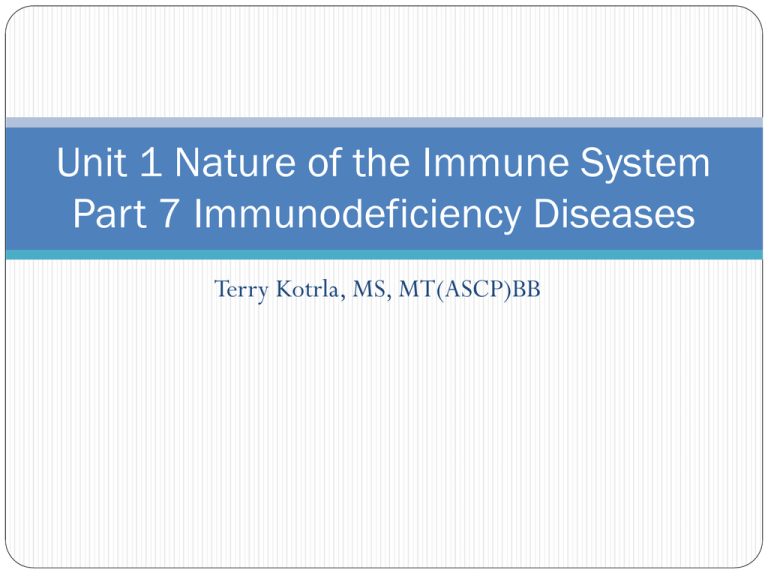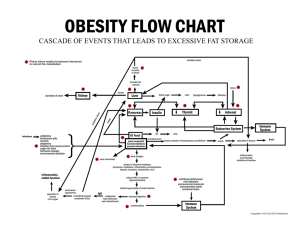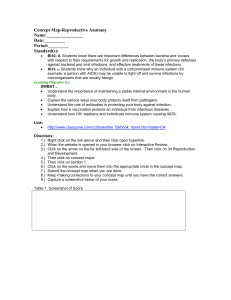Unit 1 Nature of the Immune System Part 7 Immunodeficiency Diseases
advertisement

Unit 1 Nature of the Immune System Part 7 Immunodeficiency Diseases Terry Kotrla, MS, MT(ASCP)BB Introduction The body’s immune cells attack and kill what they see as foreign invaders, usually bacteria, viruses, and fungi. Any defect in the immune system decreases a person's ability to fight infections. A person with an immunodeficiency disorder may get more frequent infections, heal more slowly, and have a higher incidence of some cancers. Immunodeficiency Disorder Immunodeficiency (or immune deficiency) is a state in which the immune system's ability to fight infectious disease is compromised or entirely absent. Immunodeficiency disorders are a group of disorders in which part of the immune system is missing or defective. Causes the body's ability to fight infections to be impaired. Person with an immunodeficiency disorder will have frequent infections that are generally more severe and last longer than usual. Immunodeficiency Disorder Defects can occur in any component of the immune system or in more than one component (combined immunodeficiency). Different immunodeficiency diseases involve different components of the immune system. The defects can be: Inherited present at birth (congenital) acquired Immune Deficiency Any of the following parts of the immune system may be affected: Humoral (adaptive) immunity – B cells Cellular immunity – T cells (remember there are 3 different kinds!) Innate immunity – natural body structures and functions. More than 120 different congenital forms of immunodeficiency have been reported. What Do I Need to Know? For each deficiency discussed you must know: The name of the disorder. What part of the immune system is affected. Brief description of the immune disorder. Immune Deficiency Disease Classification Four Classification Humoral System Deficiencies (which cell will be affected?) Cellular Immunity Deficiencies (which cell will be affected?) Combined Deficiencies Acquired Deficiencies Humoral Deficiencies Conditions which cause impairment of humoral immunity, which can lead to immunodeficiency. Caused by failures of B cells, the plasma cells they differentiate into, or the antibody secreted by the plasma cells. Associated with increased vulnerability to infection, but can be difficult to detect (or asymptomatic) in the absence of infection. Humoral Deficiencies Types we will discuss: Agammaglobulinemia X-Linked Bruton’s Agammaglobulinemia IgA Deficiency Common Variable Immunodeficiency Agammaglobulinemias Genetic defects in B-cell maturation or mutation leading to defective interaction between B- and T-cells. Many types of deficiencies involving deficiency in one or more antibody classes. Infant values different than adult, may have transient hypgammaglobulinemia. X-Linked Bruton’s Agammaglobulinemia Genetic – X-linked affects males exclusively. Lack a specific type of B cell. Exhibit deficiency of immunoglobulins of ALL classes. Have NO plasma cells. T-cells present in normal numbers and function. Develop recurrent bacterial infections. Treat with gammaglobulin as needed. Diagnosed by serum protein electrophoresis and testing for the CD19 positive B cells in peripheral blood. IgA Deficiency Most common congenital immunodeficiency, 1:500. Varying expressions of the disease and most are asymptomatic. Symptoms include respiratory and GI tract infections. Individuals who are IgA deficient may develop anti-IgA and may develop analphylactic shock during blood transfusion. No real treatment. Diagnosed by serum protein electrophoresis Common Variable Immunodeficiency Have normal number of B cells but do not develop into plasma cells. Production of one or more of the immunoglobulin types is decreased and the antibody response to infections is impaired. Generally develops around the age of 10-20. Symptoms vary, may have frequent infections, and some also will experience anemia and rheumatoid arthritis. Diagnosis of exclusion. Treat with IV immunoglobulin. Cellular Immunity Deficiencies Cell-mediated immunity is an immune response that does not involve antibodies or complement but rather involves Activation of macrophages, natural killer cells (NK), antigen-specific cytotoxic T-lymphocytes, and the release of various cytokines in response to an antigen. Cellular immunity deficiencies primarily involve problems with T-cells DiGeorge Anomaly T lymphocyte deficiency that starts during fetal development and is the result of a deletion in a particular chromosome. Children with DiGeorge syndrome either do not have a thymus or have an underdeveloped thymus. Thymus directs the production of T-lymphocytes, these patients have very low numbers of T-lymphocytes. Susceptible to recurrent infections, particularly viral and fungal. Usually have other abnormalities as well- low-set ears, a small receding jawbone, and wide-spaced eyes. In some cases, no treatment is required for DiGeorge syndrome because T lymphocyte production improves, otherwise fetal thymus transplant or bone marrow transplant. Combined Deficiencies Combined immunodeficiencies (or combined immunity deficiency) are immunodeficiency disorders that involve multiple components of the immune system, including both Humoral immunity and Cell-mediated immunity. Topics we will cover: Severe Combined Immunodeficiency Wiskott-Aldrich Syndrome Ataxia-Telangiectasia Severe Combined Immunodeficiency AKA “Bubble Boy Syndrome” Results in impaired humoral and cellular immune responses. Caused by the defective development or function of BOTH T- and B-cells. Usually recognized during the first year of life with infections by nearly any type of organism. Tends to cause a fungal infection of the mouth (thrush), diarrhea, failure to thrive, and serious infections. If not treated with a bone marrow transplant, a person with SCID will generally die from infections before age two. Wiskott-Aldrich syndrome Rare X-linked recessive disease characterized by eczema, thrombocytopenia, immune deficiency and bloody diarrhea (secondary to the thrombocytopenia). Abnormalities in both humoral and cellular immunity. Usually have low levels of IgM, normal IgG and IgA, increased IgE. Platelets have short half life and are small – why will this affect bleeding time? T-cells affected, B-cells not. Immune deficiency leaves the body vulnerable to infection, may be serious infections such as pneumonia, meningitis, and sepsis. Splenectomy can help with thrombocytopenia. BMT or cord blood stem cell transplant. Ataxia-Telangiectasia Rare, neurodegenerative, autosomal-recessive disease that affects many parts of the body and causes severe disability. Ataxia refers to poor coordination and telangiectasia to small dilated blood vessels, both are hallmarks of the disease. Combined defect of cellular and humoral immunity. Poor antibody response, IgG2, IgA and IgE low or absent. Decreased T cells Most individuals do not live long in to their 20's. Only therapy is allogeneic BMT. Defects of Neutrophil Function A defect in the life cycle of neutrophils can compromise host defenses. Defects in neutrophil functions will lead to inflammation and increased susceptibility to recurrent and severe bacterial and fungal infections. Defects of Neutrophil Function Chronic Granulomatus Disease Other Microbicidal Defects Leukocyte Adhesion Deficiency Chronic Granulomatus Disease X-lined or autosomal recessive. Phagocytes (i.e., neutrophils, monocytes and macrophages) are unable to kill bacteria and fungi. Require an enzyme to produce reactive oxygen to destroy ingested bacteria, a process known as the oxidative burst. Recurrent suppurative infections which eventually are fatal in childhood although 50% live to adulthood.. Treatment: granulocyte transfusions, cytokines or BMT Defects of Neutrophil Function Other microbicidal defects Neutrophil G6PD deficiency leads to condition similar to CGD. Myeloperoxidase deficiency – recurrent candidal infections Leukocyte Adhesion Deficiency CD18 deficiency leads to abnormal adhesion, motility, aggregation, chemotaxis and endocytosis. Several molecular defects of leukocyte adhesion cause recurrent life-threatening infections. Can cause delayed wound healing, chronic skin infections, intestinal and respiratory tract infections and periodontitis. Acquired Immunodeficiency Immune deficiency may be the result of external processes or diseases; The resultant state is called "secondary" or "acquired“ immunodeficiency. Common causes for secondary immunodeficiency are malnutrition, aging and particular medications such as chemotherapy, Many specific diseases directly or indirectly impair the immune system and include many types of cancer, particularly those of the bone marrow and blood cells certain chronic infections. acquired immunodeficiency syndrome (AIDS), caused by the human immunodeficiency virus (HIV). HIV directly infects a small number of T helper cells, and also impairs other immune system responses indirectly The End Of Part 7




